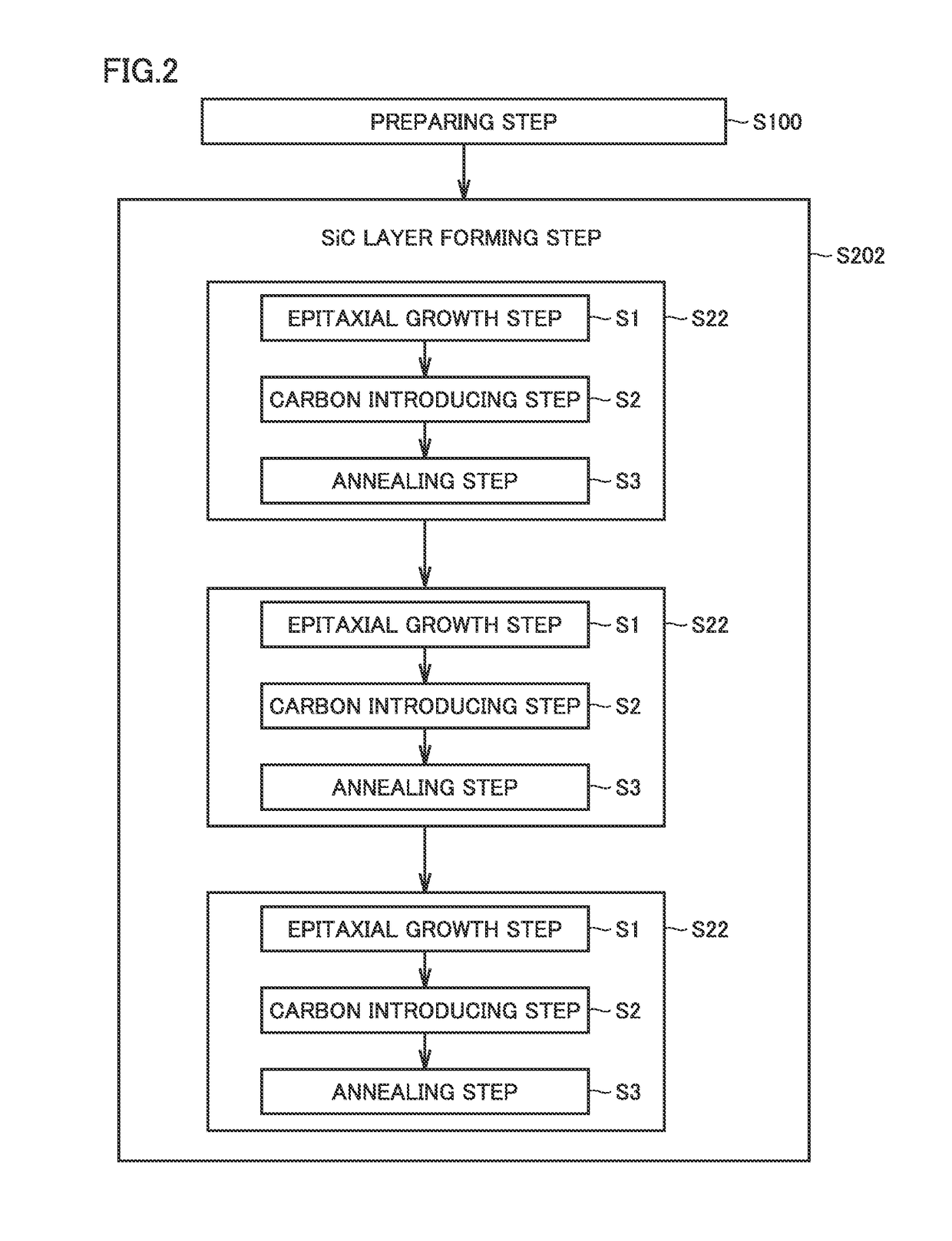Method of producing silicon carbide epitaxial substrate, silicon carbide epitaxial substrate, and silicon carbide semiconductor device
a technology of epitaxial substrate and silicon carbide, which is applied in the direction of semiconductor devices, electrical equipment, basic electric elements, etc., can solve the problems of affecting no practical use producing means have not been established, and hole-like surface defects, so as to reduce the reliability of oxide films, the yield of sic epitaxial substrates is affected, and the growth time is longer
- Summary
- Abstract
- Description
- Claims
- Application Information
AI Technical Summary
Benefits of technology
Problems solved by technology
Method used
Image
Examples
first embodiment
Method for Producing Silicon Carbide Epitaxial Substrate
[0073]A first embodiment presents a method of producing a SiC epitaxial substrate including a SiC single crystal substrate and a SiC layer epitaxially grown thereon. This production method includes a first production method, a second production method, and a third production method as follows.
[0074][1. First Production Method]
[0075]FIG. 1 is a flowchart schematically showing the first production method. With reference to FIG. 1, the first production method includes a preparing step (S100) and a first SiC layer forming step (S201). In the first production method, a series of steps (S21) including an epitaxial growth step (S1) and a polishing step (S4) are repeated twice or more in the first SiC layer forming step (S201). Here, FIG. 1 illustrates that the series of steps (S21) are repeated for 3 times, but the number of repetitions is not particularly limited as long as it is twice or more. However, in consideration of productivi...
second embodiment
Silicon Carbide Epitaxial Substrate
[0113]A second embodiment presents a SiC epitaxial substrate. FIG. 22 is a schematic view showing an example of a configuration of a SiC epitaxial substrate (wafer) according to the second embodiment. With reference to FIG. 22, SiC epitaxial substrate 100 includes SiC substrate 10 and third SiC layer 13 epitaxially grown on SiC substrate 10. SiC epitaxial substrate 100 preferably has a diameter of not less than 100 mm (for example, not less than 4 inches), and more preferably has a diameter of not less than 150 mm (for example, not less than 6 inches).
[0114]SiC epitaxial substrate 100 is typically obtained by the third production method mentioned above. Therefore, third SiC layer 13 has few defects resulting from inclusion of foreign matters and has high crystal quality. Moreover, because the surface of third SiC layer 13 is free of step-bunching, high reliability can be expected in an oxide film when the oxide film is formed thereon. Therefore, Si...
third embodiment
Silicon Carbide Semiconductor Device
[0122]A third embodiment presents a SiC semiconductor device obtained using the SiC epitaxial substrate of the second embodiment. FIG. 25 is a schematic cross sectional view showing an example of a configuration of the SiC semiconductor device according to the third embodiment. A SiC semiconductor device 1000 shown in FIG. 25 is a planar type PiN diode. SiC semiconductor device 1000 includes SiC substrate 10 and third SiC layer 13 epitaxially grown thereon. Third SiC layer 13 includes first epitaxial layer 13A, second epitaxial layer 13B, and third epitaxial layer 13C, which have been grown stepwisely.
[0123]Third SiC layer 13 serves as a drift layer. In third SiC layer 13, a p+ region 22 and a JTE region 24 are formed by ion implantation, for example. JTE region 24 is a p type region, and serves to relax electric field concentration at an end portion of pn junction. Moreover, an oxide film 26 and an anode electrode 32 are provided on third SiC lay...
PUM
| Property | Measurement | Unit |
|---|---|---|
| thickness | aaaaa | aaaaa |
| breakdown voltage | aaaaa | aaaaa |
| thickness | aaaaa | aaaaa |
Abstract
Description
Claims
Application Information
 Login to View More
Login to View More - R&D
- Intellectual Property
- Life Sciences
- Materials
- Tech Scout
- Unparalleled Data Quality
- Higher Quality Content
- 60% Fewer Hallucinations
Browse by: Latest US Patents, China's latest patents, Technical Efficacy Thesaurus, Application Domain, Technology Topic, Popular Technical Reports.
© 2025 PatSnap. All rights reserved.Legal|Privacy policy|Modern Slavery Act Transparency Statement|Sitemap|About US| Contact US: help@patsnap.com



